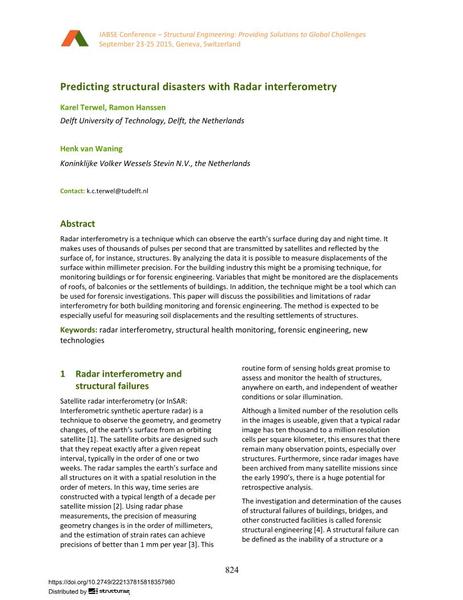Predicting structural disasters with Radar interferometry

|
|
|||||||||||
Bibliografische Angaben
| Autor(en): |
Karel Terwel
(Delft University of Technology, Delft, the Netherlands)
Henk Van Waning (Koninklijke Volker Wessels Stevin N.V., the Netherlands) Ramon Hanssen (Delft University of Technology, Delft, the Netherlands) |
||||
|---|---|---|---|---|---|
| Medium: | Tagungsbeitrag | ||||
| Sprache(n): | Englisch | ||||
| Tagung: | IABSE Conference: Structural Engineering: Providing Solutions to Global Challenges, Geneva, Switzerland, September 2015 | ||||
| Veröffentlicht in: | IABSE Conference Geneva 2015 | ||||
|
|||||
| Seite(n): | 824-831 | ||||
| Anzahl der Seiten (im PDF): | 8 | ||||
| Jahr: | 2015 | ||||
| DOI: | 10.2749/222137815818357980 | ||||
| Abstrakt: |
Radar interferometry is a technique which can observe the earth’s surface during day and night time. It makes uses of thousands of pulses per second that are transmitted by satellites and reflected by the surface of, for instance, structures. By analyzing the data it is possible to measure displacements of the surface within millimeter precision. For the building industry this might be a promising technique, for monitoring buildings or for forensic engineering. Variables that might be monitored are the displacements of roofs, of balconies or the settlements of buildings. In addition, the technique might be a tool which can be used for forensic investigations. This paper will discuss the possibilities and limitations of radar interferometry for both building monitoring and forensic engineering. The method is expected to be especially useful for measuring soil displacements and the resulting settlements of structures. |
||||
| Stichwörter: |
Radarinterferometrie
|
||||
